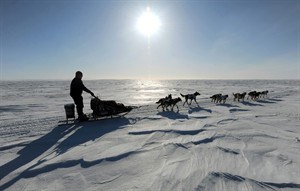
FILE - In this March 11, 2013, file photo, Alaska dog musher Aliy Zirkle drives her dog team towards Elim after leaving the checkpoint at Koyuk in Alaska during the 2013 Iditarod Trail Sled Dog Race. A lack of snow in south central Alaska and uncertain weather in the next month is again pushing organizers of the Iditarod Trail Sled Dog Race to ponder moving the start of the race from Willow to Fairbanks. (AP Photo/The Anchorage Daily News, Bill Roth, File)
Republished January 20, 2015 - 3:55 PM
Original Publication Date January 20, 2015 - 12:30 PM
ANCHORAGE, Alaska - A lack of snow in south-central Alaska has organizers of the Iditarod Trail Sled Dog Race pondering whether to move the start of the gruelling 1,609-kilometre competition from Willow to Fairbanks.
The event begins with a ceremonial start March 7 in Anchorage. Dog teams carrying passengers make a leisurely 17.7-kilometre run from downtown to an airstrip on the city's east side.
Actual racing begins a day later and usually starts in Willow. The trail takes mushers and dogs through the Alaska Range, down the Yukon River and along the Bering Sea coast to the old gold rush town of Nome.
Race organizers in 2003 moved the start of the race to Fairbanks on the north side of the Alaska Range because of low snow and poor trail conditions. They were criticized for not doing so last year.
Norwegian musher Robert Sorlie, who won the race in 2005, survived a harrowing trip through the Dalzell Gorge and Farewell Burn in the Alaska Range.
"They should not send people out there. It's not safe," said Sorlie, a firefighter, while in Nikolai. "I've never been so scared before in my life."
Race marshal Mark Nordman is watching current trail conditions closely, the Fairbanks Daily News-Miner reported (http://bit.ly/15sCMKr). One big storm could change everything, he said.
"Plan A is going over the Alaska Range. That's still what we're working on," he said. "And with the reception we had in 2003, we would hope Fairbanks would be excited if Plan B would need to happen."
The Dalzell Gorge and the Farewell Burn need more snow, he said. There also might be open water on the Yukon River above Galena, Nordman said. From Unalakleet on the Bering Sea coast, there's a thin snowpack too, he said.
Temperatures rose last year after the decision was made to use the traditional route, Nordman said.
The Iditarod Trail Committee will decide in mid-February whether the race will follow its normal route or restart in Fairbanks. Lead time is needed because mushers drop off food at checkpoints and race officials must plan logistics, Nordman said.
There's pressure from locations along the traditional route to keep it, Nordman said.
Cities and businesses along the traditional route want organizers to stick to the usual trail, Nordman said.
"When we don't come through a village, it'll be a big hit," he said. "But they all realize. They see it every day. Their travel is harder because of the lack of snow in some places."
Nordman added his ultimate responsibility is to the dogs and mushers.
___
Information from: Fairbanks (Alaska) Daily News-Miner, http://www.newsminer.com
News from © The Associated Press, 2015